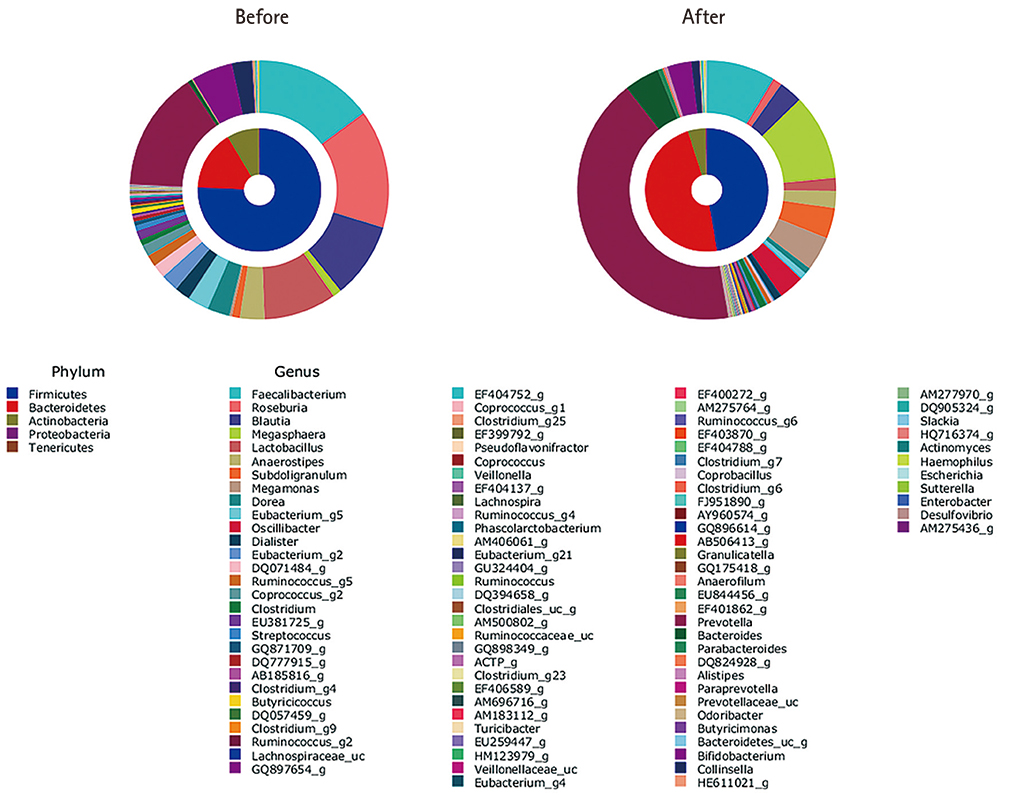Clin Nutr Res.
2016 Apr;5(2):137-140. 10.7762/cnr.2016.5.2.137.
Six-week Diet Correction for Body Weight Reduction and Its Subsequent Changes of Gut Microbiota: A Case Report
- Affiliations
-
- 1Department of Family Medicine, Seoul National University Boramae Hospital, Seoul 07061, Korea. bumjo.oh@gmail.com
- 2Nutrition Department, Seoul National University Boramae Hospital, Seoul 07061, Korea.
- 3Department of Life Sciences, Hallym University, Chuncheon 24252, Korea.
- 4Graduate School of Public Health, Seoul National University, Seoul 08826, Korea.
- KMID: 2168231
- DOI: http://doi.org/10.7762/cnr.2016.5.2.137
Abstract
- Impact of intestinal microbes on obesity and health is a new topic recently started to get attention. Comparing to the global concern and research trends, there are few research on the association between intestinal bacteria and life style disease in Korean. One voluntary case (female) was reported to show the change in gut microbiota and weight by diet intervention. She was overweight (BMI 23.2 kg/m2) and has abnormal liver function, and the causes of overweight were frequent drinking and meat consumption at the late evening hours. For 47 days, she was administered an improved diet on breakfast and dinner with reduction of meat consumption frequency by 50%. Alcohol consumption was reduced to once a week. As a result, she lost 3 kilograms of body weight. Her fecal sample was collected before and after the intervention, and gut microbiota change was compared using a high-throughput sequencing technique. After diet correction, the shift of gut microbiota was clearly observed with decreased proportion of Firmicutes (from 75.7% to 47.3% in total microbiota) but increased proportion of Bacteroidetes upto 47.7%. After incorporating the diet intervention, it is meaningful to confirm the changes in dominant gut microbiota and weight loss.
Keyword
MeSH Terms
Figure
Reference
-
1. Kang HT, Shim JY, Lee HR, Park BJ, Linton JA, Lee YJ. Trends in prevalence of overweight and obesity in Korean adults, 1998-2009: the Korean National Health and Nutrition Examination Survey. J Epidemiol. 2014; 24:109–116.
Article2. Jensen MD, Ryan DH, Apovian CM, Ard JD, Comuzzie AG, Donato KA, Hu FB, Hubbard VS, Jakicic JM, Kushner RF, Loria CM, Millen BE, Nonas CA, Pi-Sunyer FX, Stevens J, Stevens VJ, Wadden TA, Wolfe BM, Yanovski SZ, Jordan HS, Kendall KA, Lux LJ, Mentor-Marcel R, Morgan LC, Trisolini MG, Wnek J, Anderson JL, Halperin JL, Albert NM, Bozkurt B, Brindis RG, Curtis LH, DeMets D, Hochman JS, Kovacs RJ, Ohman EM, Pressler SJ, Sellke FW, Shen WK, Smith SC Jr, Tomaselli GF. American College of Cardiology/American Heart Association Task Force on Practice Guidelines. Obesity Society. 2013 AHA/ACC/TOS guideline for the management of overweight and obesity in adults: a report of the American College of Cardiology/American Heart Association Task Force on Practice Guidelines and The Obesity Society. Circulation. 2014; 129:S102–S138.3. Lichtenstein AH, Kennedy E, Barrier P, Danford D, Ernst ND, Grundy SM, Leveille GA, Van Horn L, Williams CL, Booth SL. Dietary fat consumption and health. Nutr Rev. 1998; 56:S3–S19.
Article4. Shen J, Obin MS, Zhao L. The gut microbiota, obesity and insulin resistance. Mol Aspects Med. 2013; 34:39–58.
Article5. Turnbaugh PJ, Hamady M, Yatsunenko T, Cantarel BL, Duncan A, Ley RE, Sogin ML, Jones WJ, Roe BA, Affourtit JP, Egholm M, Henrissat B, Heath AC, Knight R, Gordon JI. A core gut microbiome in obese and lean twins. Nature. 2009; 457:480–484.
Article6. Tilg H. Obesity, metabolic syndrome, and microbiota: multiple interactions. J Clin Gastroenterol. 2010; 44:Suppl 1. S16–S18.7. Turnbaugh PJ, Gordon JI. The core gut microbiome, energy balance and obesity. J Physiol. 2009; 587:4153–4158.
Article8. Oh SW, Shin SA, Yun YH, Yoo T, Huh BY. Cut-off point of BMI and obesity-related comorbidities and mortality in middle-aged Koreans. Obes Res. 2004; 12:2031–2040.
Article9. Jeon YS, Chun J, Kim BS. Identification of household bacterial community and analysis of species shared with human microbiome. Curr Microbiol. 2013; 67:557–563.
Article10. Gudzune KA, Doshi RS, Mehta AK, Chaudhry ZW, Jacobs DK, Vakil RM, Lee CJ, Bleich SN, Clark JM. Efficacy of commercial weight-loss programs: an updated systematic review. Ann Intern Med. 2015; 162:501–512.11. Ley RE, Turnbaugh PJ, Klein S, Gordon JI. Microbial ecology: human gut microbes associated with obesity. Nature. 2006; 444:1022–1023.
- Full Text Links
- Actions
-
Cited
- CITED
-
- Close
- Share
- Similar articles
-
- A ketogenic diet reduces body weight gain and alters insulin sensitivity and gut microbiota in a mouse model of diet-induced obesity
- Modulation of Gut Microbiota: Potential Mechanism of Diabetes Remission after Bariatric/Metabolic Surgery
- Microbiota: A Key for Healthy Aging
- High-fat-diet-modulated Gut Microbiota Promotes Intestinal Carcinogenesis
- Pathogenic role of the gut microbiota in gastrointestinal diseases


